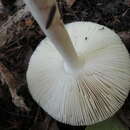en
names in breadcrumbs


Amanita albocreata, also called the ringless panther[2] or the ringless panther amanita,[3] is a species of fungus in the family Amanitaceae. It was discovered in 1944, by William Murrill. It is commonly found in northeastern United States and southeastern Canada and elsewhere in North America. This species, that grows about 5 to 15 centimeters in length, is doubted to be fatally toxic. It normally grows between the rainy months of June and August.[4]
First described in 1902 by George Francis Atkinson under the name Amanitopsis albocreata,[5] the species was transferred to Amanita in 1941 by Jean-Edouard Gilbert.[6]
This fungus is found in the hardwood-hemlock (Tsuga) forest of the northeastern U.S. and southeastern Canada and of boreal forest at least as far north as the Island of Newfoundland. Commonly it is found in coniferous and deciduous forests or open lush green grasslands.[4]
The species is considered inedible and possibly poisonous.[9][2]
Amanita albocreata, also called the ringless panther or the ringless panther amanita, is a species of fungus in the family Amanitaceae. It was discovered in 1944, by William Murrill. It is commonly found in northeastern United States and southeastern Canada and elsewhere in North America. This species, that grows about 5 to 15 centimeters in length, is doubted to be fatally toxic. It normally grows between the rainy months of June and August.